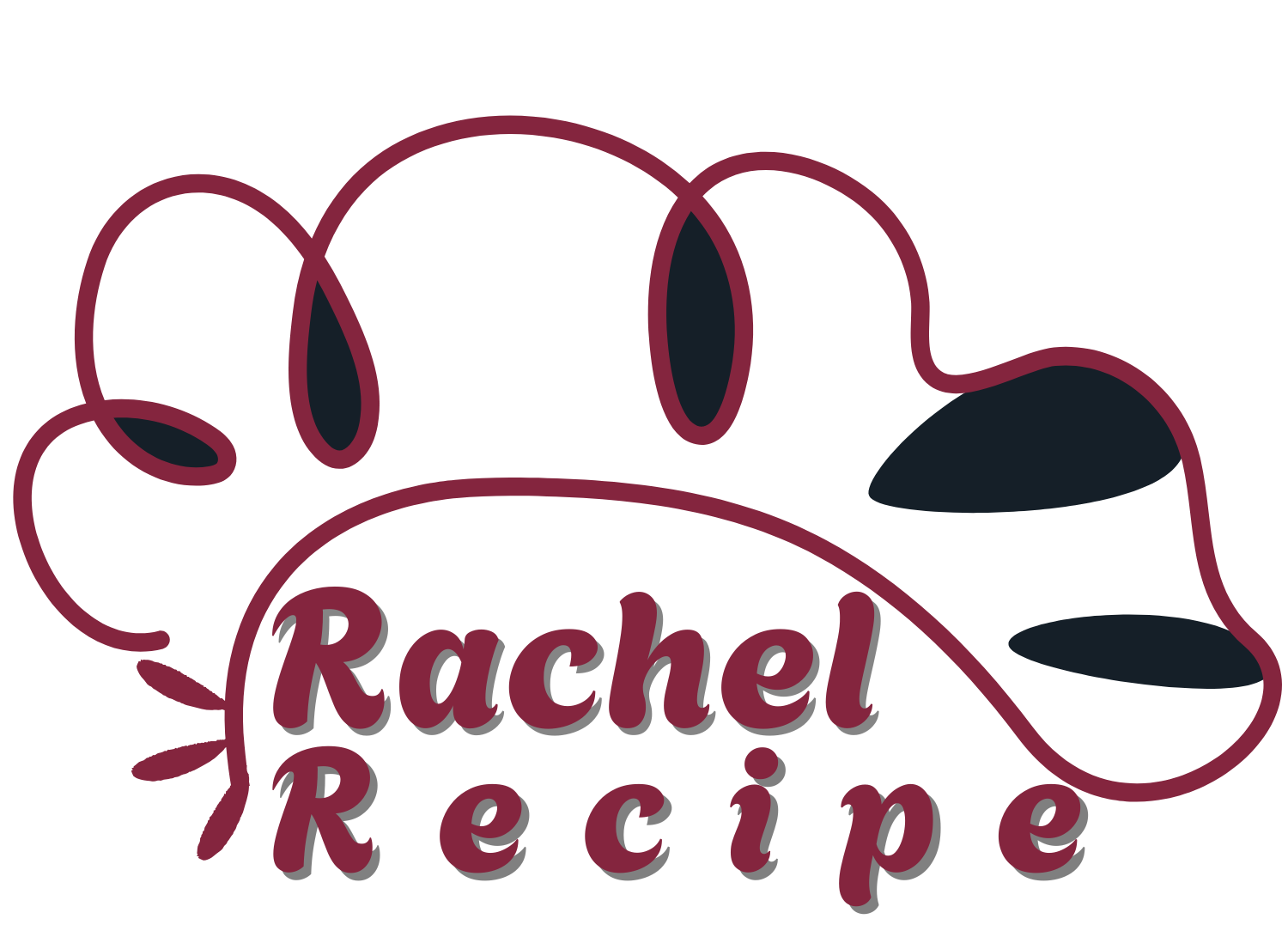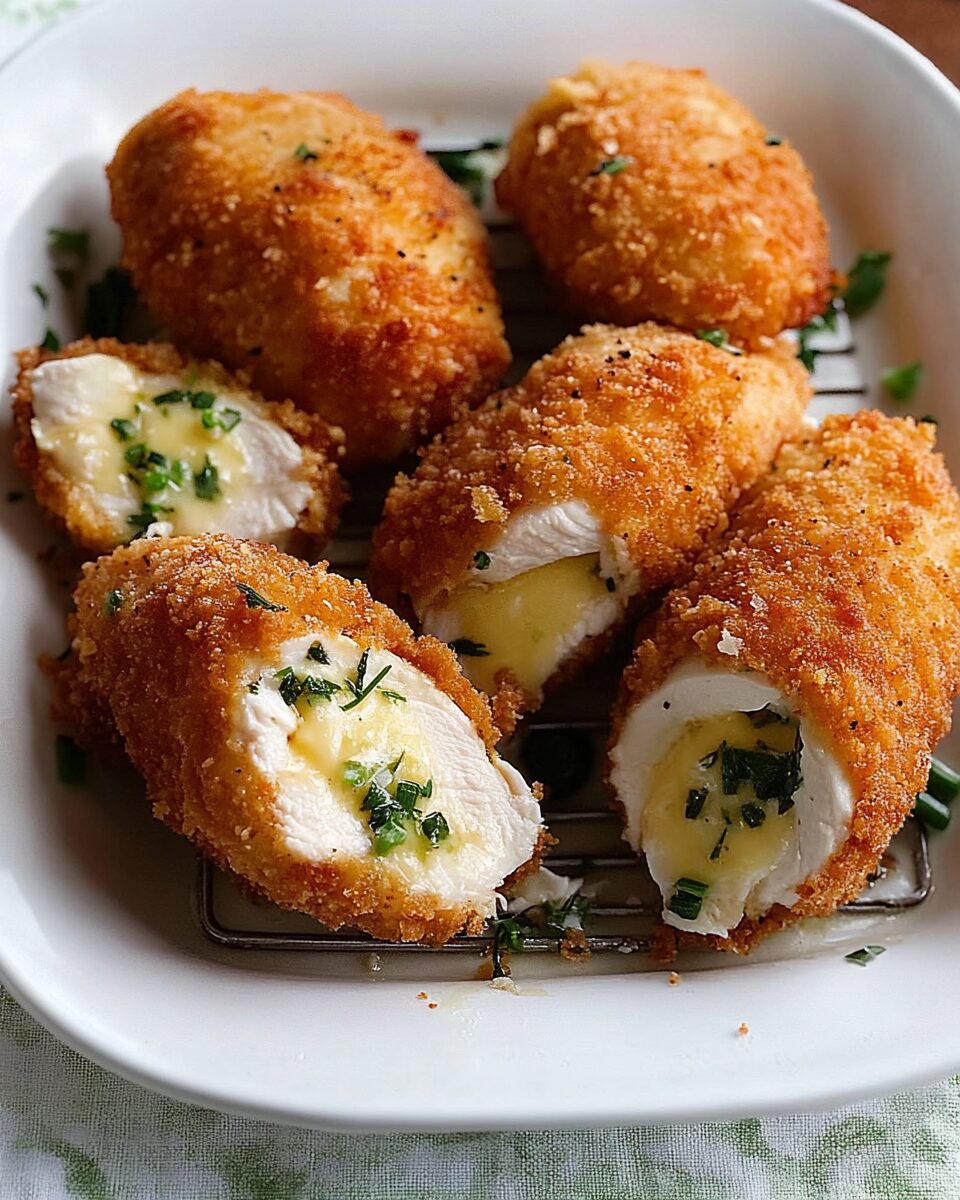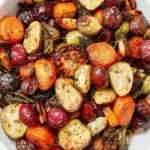The beloved Chicken Kiev is a true classic that brings elegance to your dinner table. With a center of rich herb-infused butter that melts into the tender chicken as you cut into it, this dish strikes a beautiful balance between decadent flavor and refined texture.
What makes it irresistible is the double-cooking method—pan-fried for that shattering crust, then gently baked to juicy perfection. Whether you’re preparing a cozy weeknight meal or hosting a special gathering, this dish delivers restaurant-level sophistication right from your home kitchen.
Full Recipe:
-
2 sticks unsalted butter, softened
-
3 tablespoons finely chopped fresh tarragon
-
3 tablespoons finely chopped fresh parsley
-
3 tablespoons finely chopped fresh chives
-
2 teaspoons finely chopped fresh thyme
-
Kosher salt and freshly ground black pepper
-
6 small skinless, boneless chicken breasts (about 2 1/4 pounds)
-
1 cup all-purpose flour
-
4 large eggs
-
1 tablespoon Dijon mustard
-
2 cups panko breadcrumbs
-
Vegetable oil, for frying
Directions:
-
In a bowl, mix butter, tarragon, parsley, chives, thyme, 1 teaspoon salt, and 1/4 teaspoon pepper.
-
Spoon the mixture onto plastic wrap and roll into a 1-inch-thick log. Freeze until firm (at least 3 hours or up to 3 days).
-
Slice the frozen herb butter into 6 equal pieces.
-
Lay each chicken breast between plastic wrap or resealable bags and pound to 1/4-inch thick.
-
Season chicken with salt and pepper. Place a piece of herbed butter in the center and roll tightly, tucking in sides. Wrap tightly in plastic.
-
Chill rolls in the refrigerator for at least 2 hours or overnight.
-
Preheat oven to 350°F. Line a baking sheet with a wire rack.
-
Set up breading stations: flour in one dish, whisked eggs and Dijon in another, panko in a third.
-
Unwrap chicken rolls. Season again with salt and pepper. Dredge each roll in flour, dip in egg mixture, and coat with panko.
-
Heat 1/2 inch of vegetable oil in a skillet over medium-high heat. Fry rolls in batches, turning, until golden (6–8 minutes).
-
Transfer to the rack and bake for 10 minutes or until cooked through.
Prep Time: 1 hour | Cooking Time: 20 minutes | Total Time: 1 hour 20 minutes
Kcal: 610 kcal (approx.) | Servings: 6
A Delectable Classic: Exploring the History and Allure of Chicken Kiev
Chicken Kiev is one of those rare dishes that simultaneously feels nostalgic and refined—a culinary experience where comfort meets sophistication. Known for its golden-brown crust and irresistible explosion of herb-infused butter upon cutting into the juicy chicken, Chicken Kiev offers a balance of textures and flavors that never fails to impress. Whether served as a centerpiece for a dinner party or as a special family meal, this timeless classic remains a beloved staple in kitchens around the world.
The Origins of Chicken Kiev
Despite its name, the origins of Chicken Kiev are somewhat disputed. Many associate it with Ukraine’s capital, Kyiv, and it certainly holds a place of cultural pride there. However, culinary historians trace the roots of this dish back to both French and Russian cuisine.
In the 18th century, French cuisine heavily influenced the Russian imperial court, particularly during the reign of Catherine the Great. Dishes like côtelette de volaille, a stuffed chicken cutlet similar in style, were likely precursors to the modern Chicken Kiev. Russian chefs, trained in French techniques, may have adapted and popularized this dish, giving it the Eastern European touch that defines it today. Over time, it became widely known as Chicken Kiev, particularly in English-speaking countries, where it became a restaurant staple during the 20th century.
Why Chicken Kiev is So Loved
At its core, Chicken Kiev offers an unbeatable combination of textures and flavors. A crisp, golden crust envelops a juicy chicken breast that’s been carefully rolled around a chilled log of herb-infused butter. When sliced open, the hot butter oozes out, carrying with it the aromatic notes of fresh herbs like tarragon, parsley, chives, and thyme. It’s a sensory experience, both visually dramatic and deeply satisfying to taste.
Part of the appeal lies in its balance—crunchy on the outside, succulent on the inside, and rich with the unmistakable flavor of high-quality butter infused with herbs. It’s a dish that feels indulgent without being overly complex.
Modern Takes on a Culinary Icon
Although the traditional version remains widely celebrated, chefs and home cooks alike have come up with creative reinterpretations of Chicken Kiev over the years. Some opt for garlic butter instead of herbs alone, adding boldness to the flavor profile. Others incorporate breadcrumbs with grated cheese or crushed nuts for added texture.
For health-conscious eaters, oven-baked versions have become popular, eliminating the need for pan-frying without sacrificing flavor. Air fryers also offer a modern twist, delivering crispiness with significantly less oil. Even vegetarian or vegan spins—using tofu or seitan stuffed with dairy-free herb butter—have found their way into the culinary conversation, demonstrating the dish’s versatility.
A Dish of Technique and Timing
What sets Chicken Kiev apart from simpler recipes is the technique involved. It’s a dish that rewards patience and attention to detail. The butter must be prepared and frozen ahead of time to ensure it holds its shape during the cooking process. The chicken must be pounded to just the right thickness—thin enough to roll, but thick enough to retain moisture.
Sealing the chicken properly is also essential to avoid butter leakage during cooking. Finally, the breading process adds a protective layer, enhancing both texture and flavor. From preparation to plating, each step requires care, but the payoff is undeniable.
Ideal Occasions for Chicken Kiev
Though it might not be your everyday weekday dinner (unless you love prepping ahead), Chicken Kiev is perfect for special occasions. Think romantic dinners, birthdays, holiday meals, or dinner parties. Its dramatic presentation—golden crust and luscious butter center—makes it a memorable entrée for guests. Pair it with simple sides like mashed potatoes, buttered peas, roasted vegetables, or a fresh green salad to let the main dish shine.
It’s also an excellent make-ahead dish. Once rolled and wrapped, the chicken can be stored in the fridge overnight or even frozen for later use. This allows hosts to spend more time with their guests rather than being stuck in the kitchen.
Serving Suggestions and Pairings
Because of its richness, Chicken Kiev benefits from light and fresh accompaniments. A crisp green salad with lemon vinaigrette balances the buttery interior of the chicken. Steamed or roasted seasonal vegetables—like asparagus, green beans, or carrots—add color and texture to the plate. For starch, opt for buttery mashed potatoes, herbed rice, or even crusty bread to soak up the melted butter.
In terms of wine pairing, white wines with acidity and freshness—like Sauvignon Blanc, Chardonnay, or a dry Riesling—work well to cut through the richness. A sparkling wine can also elevate the dining experience, adding a festive feel and a palate-cleansing effect.
Cultural Impact and Global Reach
Chicken Kiev has long transcended its Eastern European roots. In the mid-to-late 20th century, it was a popular restaurant dish in the UK, the US, and Australia, often featured in upscale hotel menus or frozen dinner offerings. Though it briefly fell out of fashion as global cuisines expanded into more exotic and diverse territories, its revival in recent years speaks to a renewed appreciation for comfort food and culinary heritage.
In Ukraine, it remains both a point of cultural pride and a dish frequently served in restaurants and homes. The recipe has also found its way into cookbooks, culinary schools, and food blogs worldwide, making it accessible to new generations of home cooks.
Chicken Kiev in Pop Culture and Media
Beyond the dinner table, Chicken Kiev has been referenced in literature, television, and film as a symbol of classic European cuisine. It often appears in period dramas or shows that depict elegant dinners and formal gatherings. Its name alone evokes a sense of old-world charm and gastronomic sophistication.
Moreover, as cooking shows and food influencers revive and reinvent classic recipes, Chicken Kiev is once again enjoying the spotlight. It frequently features in online tutorials, viral food videos, and culinary competitions, proving that its appeal endures in the digital age.
Nutritional Considerations
Chicken Kiev, while indulgent, can be made more balanced with a few smart choices. Using lean chicken breasts keeps the protein content high, and controlling the amount of butter helps manage the fat content. Baking instead of frying significantly reduces overall calories and saturated fat. Whole wheat panko or nut-based coatings add fiber and nutrients, further enhancing the dish’s nutritional value.
For those with dietary restrictions, gluten-free breadcrumbs or dairy-free butters are readily available alternatives that allow for easy customization without sacrificing taste or texture.
Conclusion
Chicken Kiev is more than just a dish—it’s a celebration of culinary craft, cultural heritage, and timeless flavor. From its debated origins to its widespread modern adaptations, it holds a special place in both Eastern European tradition and Western comfort food culture. Its appeal lies in its contrasts: crunchy and soft, rich and fresh, simple in ingredients yet demanding in technique.
Whether you stick with the classic version or experiment with new twists, making Chicken Kiev at home is a gratifying culinary project that yields restaurant-quality results. It’s the kind of dish that tells a story with every bite—of where it comes from, of how it’s made, and of the care and passion that goes into preparing it.
Add Chicken Kiev to your culinary repertoire not just as a recipe, but as an experience—a dish to savor, share, and celebrate.






